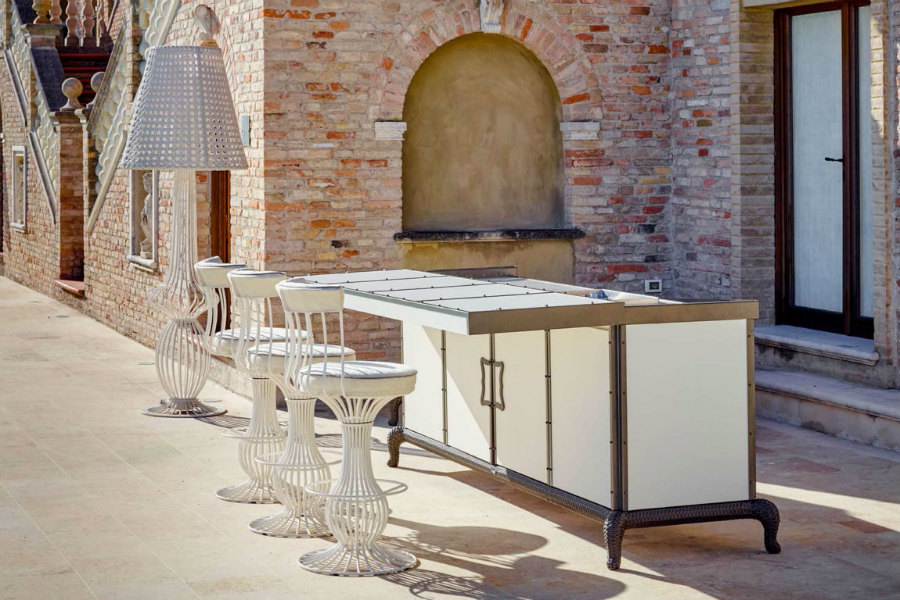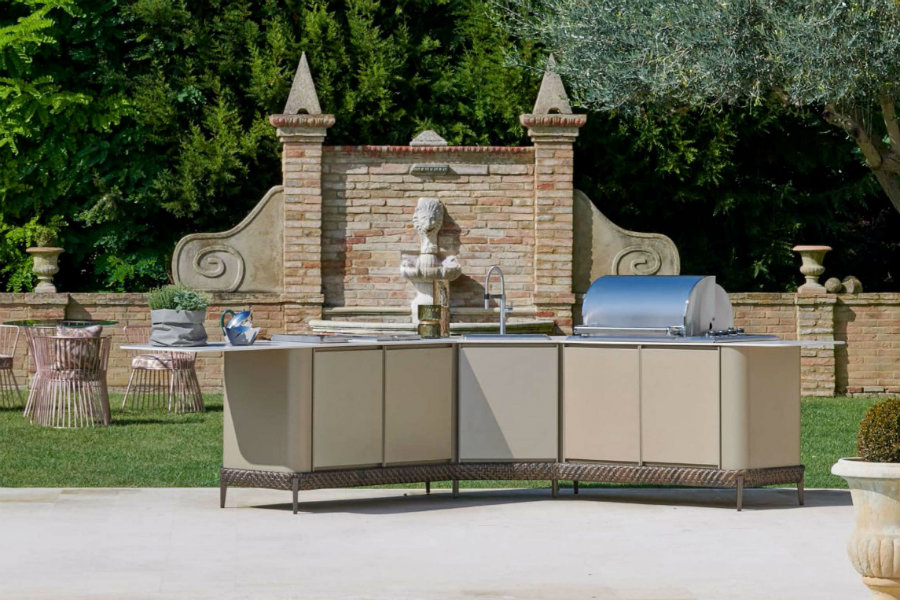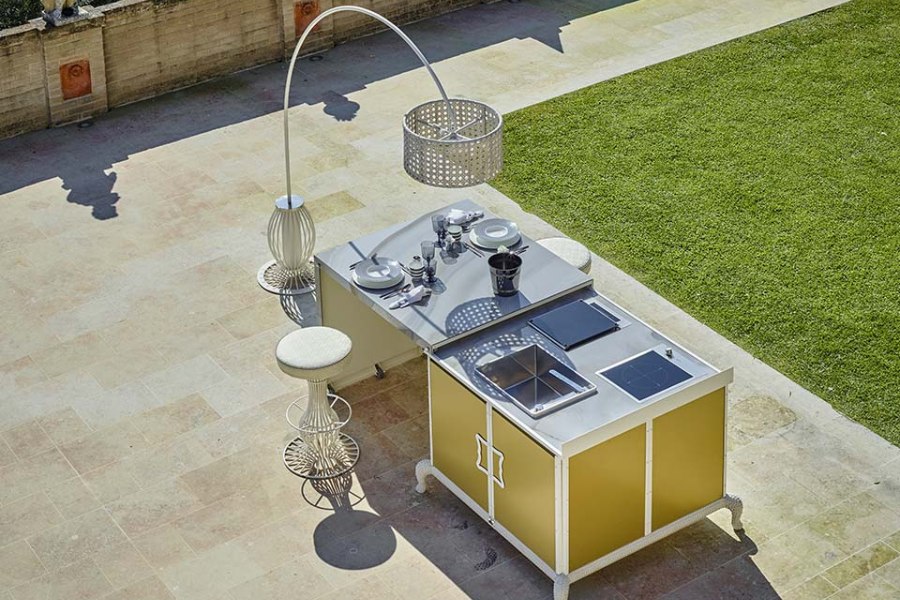
Outdoor kitchens are realised as an extension of the living area of the main house and can represent a opportunity to experience the outdoors as much as possible. In addition to adding a livable space to the property, outdoor kitchens are one of the main requests designers receive when dealing with the enhancement of outdoor areas.
Among the most important decisions to be made, first, there is the definition of a kitchen’s layout. There are many different options, including the L shape, the U shape, the islands and the linear kitchens. To better define the most suitable layout for our specific case, we must consider what is more in tune with the main house.
Layout options for an exclusive outdoor kitchen
When it comes to an outdoor kitchen, there is no perfect solution for every situation. The shape, size and style of the structure are influenced by a series of variables that make a project perfect for the home and totally out of place for another. It is up to the designer to create a structure that is perfectly integrated into the property.
By focusing on the various layout options for an outdoor kitchen, the designer has the opportunity to choose the most suitable solution for the context and from there develop a perfectly customised, unique and exclusive idea. Going with the order, after having made the appropriate evaluations regarding the available space and the outdoor kitchen must-haves, the designer can define the perfect layout to create an oasis able to satisfy the client's needs.
What considerations should be made?
Outdoor kitchens are composed of the same functional areas as indoor kitchens, and the requirements for the use of these areas are also similar for both types of environments. In particular, the hot areas (grills, hobs, ovens, etc.), cold areas (freezers, refrigerators, wine cellars, etc.), wet areas (sinks, tanks for ice or drinks, etc.) and dry areas (countertops for the preparation of food, bars, shelves and storage furniture) are identified.
In small kitchens, cold and wet areas can also be avoided. However, dry areas are essential even in smaller kitchens. For these, as well as for all the areas that will be foreseen in the project, it is fundamental to provide sufficient space for the respective purposes of use. It is also important to consider their relationship, for example, avoiding obstacles between them or positioning them close to excessively trafficked areas to make the food preparation workflow easy and linear.

Corner kitchens
Among the layout options for the most popular outdoor kitchen, the classic L shape for the corner structure stands out. It is a very popular layout because of its ability to adapt to existing spaces and structures, also because its shape facilitates the reduction or enlargement of its components.
The diffusion of the L-shaped structures is linked to the fact that these often represent an uninterrupted extension of already existing walls for an even more natural flow.
On the other hand, if you have large spaces available, you can expand an L-shaped kitchen, enhancing it with numerous appliances and exclusive details, as well as storage spaces. From this point of view, it is possible to insert grids, ovens, refrigerators or freezers into the project as well as various accessories to store utensils and crockery easily.
This layout is also perfect for combining the cooking area with the area dedicated to entertainment. From a functional point of view, a similar triangular layout facilitates the various stages of preparation, ensuring easy access to raw materials and work tools, as well as to cooking zones, making the space simple and efficient without compromising the interactions.
In this regard, since many guests prefer to stay near the cooking area to spend time with the owner, it is possible to enhance the L-shaped kitchen with a sort of bar counter with stools. Guests can then stay near the cooking area without hindering whoever is at the hob, allowing them concentrate on preparing dishes.
In conclusion, if the outdoor kitchen is supposed to be on a terrace rather than in the home garden, an L-shaped or simply linear layout will be a more than valid option.
Advantages of an L-shaped kitchen
Summarising what has just been said, a kitchen with an angular layout:
- is perfect for corner spaces
- is characterised by worktops and furniture that can be adjusted in length according to the available space
- ensures a triangular workspace in which to move smoothly
- is perfect for projects focused on open spaces
U-shaped kitchens
The U shape, among the various layout options for an outdoor kitchen, is perfect for re-proposing the same spaces that are generally used for indoor kitchens for the outdoors. This layout works perfectly for freestanding kitchens and gives them plenty of space for storage as well as for food preparation. Since U-shaped kitchens are made up of three sides, they can be equipped with any appliance, ample furniture and even a service level where you can place dishes that are ready to be served.
Surely this kind of layout often provides a wing that is dedicated to a counter with stools. The latter are often present on the outside along the entire U so that guests can interact with the homeowner intent on preparing dinner.
This layout option for outdoor kitchens is usually preferred in the case of projects involving roofs or, in any case, covers.
The presence of a ceiling also allows the addition of lighting, air conditioning or heating systems and other amenities that make the space enjoyable in every condition and situation. This is because, as some experts in the sector confirm, the kitchen is much more than the heart of the home. Everyone ends up sitting near the cooking area. Integrating the entertainment area with the food preparation area is a great way to ensure an even more pleasant experience for the homeowner as well as for guests.
Advantages of a U-shaped kitchen
Summarising, a kitchen with a similar layout:
- fully reflects traditional indoor kitchens, bringing the interior style of the house outdoors
- is usually large, guaranteeing even more exclusivity to the project and consequently significantly increasing the value of the entire property
- considering its dimensions, can be enriched with infinite details, and any amenities can be added
- can accommodate many guests thanks to the destination of one of its wings for the creation of a bar counter
Linear kitchens and islands
Island kitchens, as well as linear ones, are extremely versatile because they are structures that work independently or as an extension of another project, creating additional space. An island is the perfect layout option for small outdoor kitchens if it is a separate structure. Generally, the grid and the appliances are grouped into a single central unit. In spite of the often smaller dimensions compared to corner projects and especially to U-shaped kitchens, even linear solutions or islands can be enhanced with cutting-edge appliances and details such as refrigerators or wine cellars.
Furthermore, their compactness can make them an exclusive embellishment of pre-existing areas. Consider for example the installation of a poolside island kitchen, an unusual and special solution that would allow the homeowner, who is preparing food, to interact with guests while they are relaxing in the water.
However, if the island is intended as an integral part of a larger project rather than an extension of an existing structure, its function is to increase the space and not to function as a kitchen in its own right. Therefore, if the island serves as a place to prepare food, the remaining parts of the project in which it is inserted can accommodate utensils or food, serving as a storage space. With this in mind, linear kitchens or islands are perfect for clients who want to experiment with new layouts and are open to innovative concepts.
Beyond the intended use of an island, it is one of the most common layout options for outdoor cooking thanks to its versatility.
With the simple addition of a counter, an island acts as the perfect partition between the cooking area and the area dedicated to entertainment. In this case, those who are intent on preparing food can continue their work without interruption and above all without losing touch with what is going on around them.
From a functional point of view, a linear kitchen, as well as an island, are easy to use; they optimise the chef’s performance and are extremely versatile as well as customisable down to the smallest detail. Among the latest trends, for example, the creation of sliding covers, that in times of inactivity, protect the kitchen’s top. When the kitchen is in use, and the cover is open, it can serve as a support surface or as a snack counter.
The advantages of an island or linear kitchen
Considering what has been said above, an island, as well as a linear kitchen, offer the client the following advantages:
- an island is composed of a free-standing structure on all sides
- it is a modern layout that is very much appreciated even inside the home
- guests can interact freely with the owner intent on preparing food without interrupting
- this layout creates a space where guests naturally tend to get together without compromising the panorama and invading the view of the outdoor space as a whole too much
- guests can sit or otherwise position themselves in front of the chef, who in turn will not turn their back to anyone, being able to position and orient the island in the most functional way
- according to some estimates, this design option for outdoor kitchens is among the most requested due to its incredible versatility
The icing on the cake
The variants proposed here have been tested and their functionality proven. Depending on the context, the designer will be able to orientate towards one choice or the other to propose a bespoke solution suitable for the property. Each of these layout options for outdoor kitchens, if well integrated into the external environment in terms of proportions and aesthetics, will contribute to increasing the value of the property in an important way, representing, for all intents and purposes, the classic icing on the cake.



